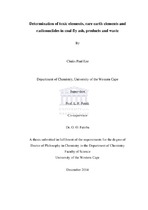| dc.description.abstract | Coal fly ash has been studied extensively to understand the environmental impacts associated with its disposal, management and reuse. Although several beneficiation processes have been proposed, there has been little or no emphasis on the environmental safety of such processes, products and wastes. Elemental analysis has revealed that toxic elements and radionuclides are present in coal fly ash. Rare earth elements (REE) such as La, Ce and Y are also present in significant amounts in coal fly ash. The aims of this study were to determine the total elemental composition of coal fly ash using different analytical techniques; to validate the application potentials of fly ash beneficiation processes in terms of their environmental safety; and to valorise coal fly ash with a view of recovering REE either by concentrating or leaching the REE in the coal fly ash, products or waste from the beneficiation processes. The beneficiation processes studied were treatment of acid mine drainage (AMD) with fly ash; and the synthesis of geopolymer from fly ash. The fresh fly ash sample used in this study was collected directly from the hoppers at Matla power station and the AMD sample was collected from Carletonville goldmine. A total of 54 major, trace and REE were accurately determined in the ash using different analytical techniques. It was shown that the elemental content of Matla fly ash was of the same order as the SRM NIST coal fly ash 1633b. The comparative study of the four analytical techniques established that ENAA can accurately determine the major, minor and trace elements; that XRF is best suited for the determination of the major and minor elements, whilst the LA ICP-MS is reliable for trace elements determination. The solid residue (AMD/FA) resulting from the AMD interaction with fly ash was characterized with fly ash and the results compared. The results revealed that the amounts of La (141.09 ± 3.85 mg/kg), Ce (27.45 ± 2.04 mg/kg), and Nd (63.73 ± 0.05 mg/kg) in AMD/FA residue was considerably higher than their average abundance in the earth crust that varies from 66 mg/kg in Ce and 40 mg/kg in Nd to 35 mg/kg in La. The results also showed that the AMD/FA residue contained As (11.39 ± 1.21 mg/kg), Cd (3.77 ± 0.02 mg/kg), Cr (72.43 ± 1.27 mg/kg), Hg (10.50 ± 0.85 mg/kg), Ni (124.15 ± 1.6 mg/kg) and Pb (22.46 ± 1.43 mg/kg) which are potentially harmful if leached in to the environment in excessive amounts. | en_US |

